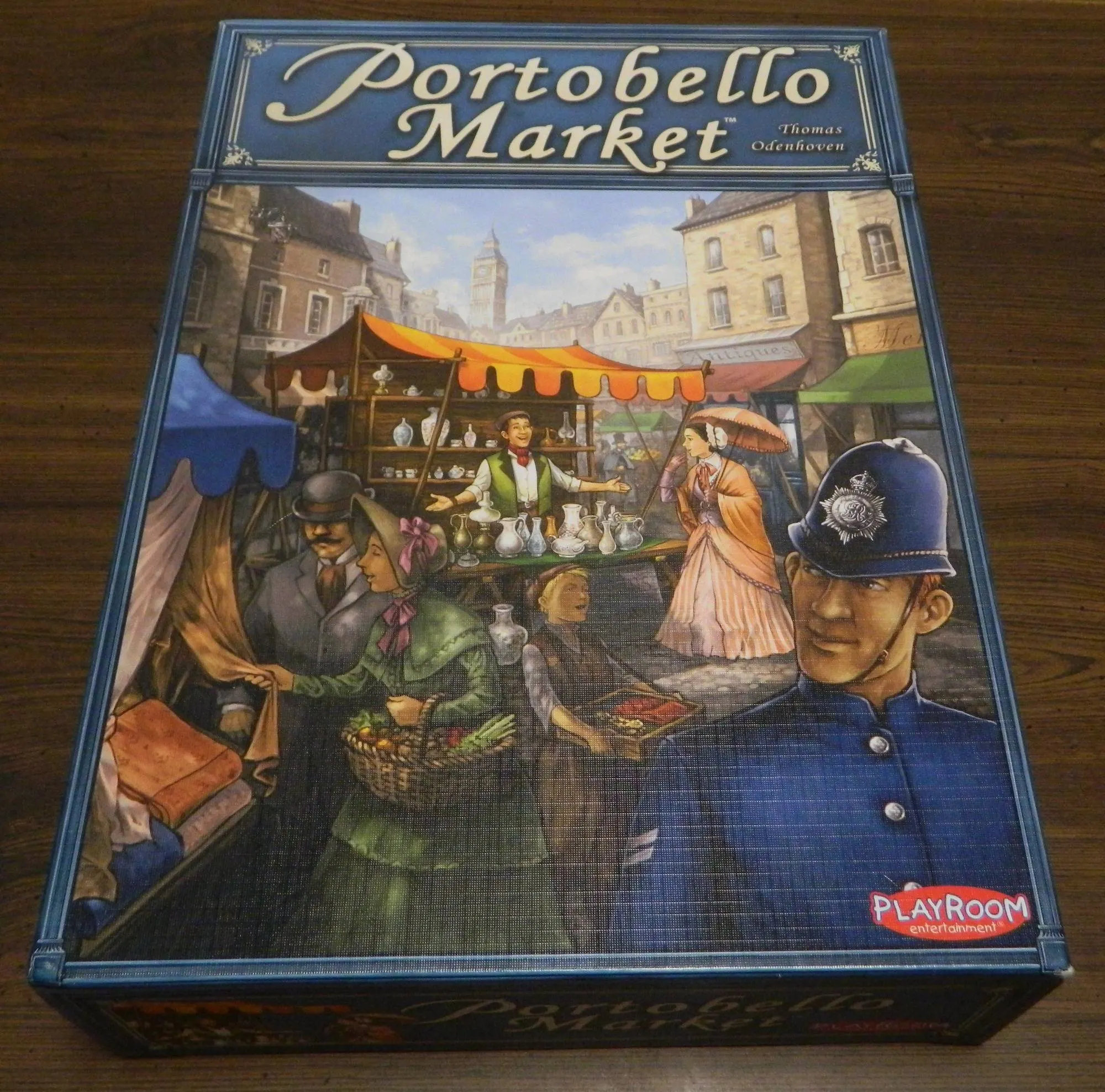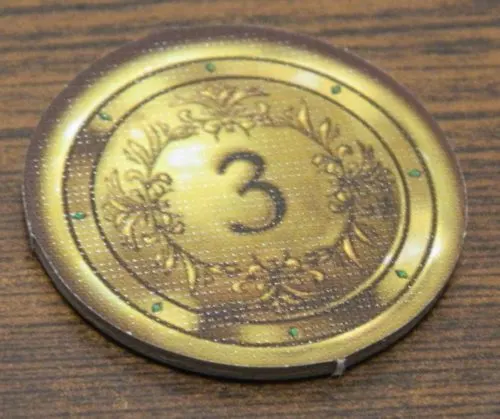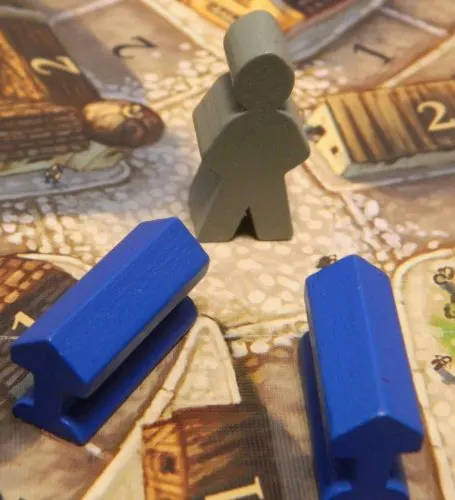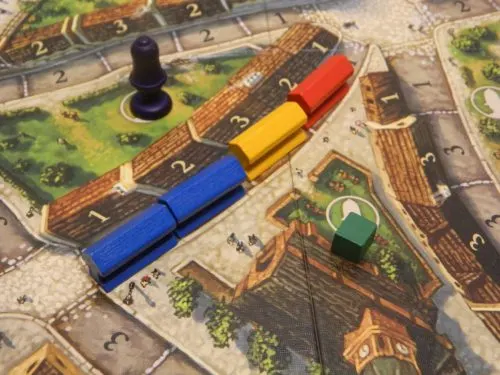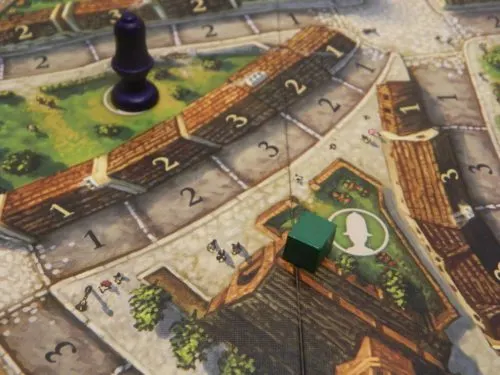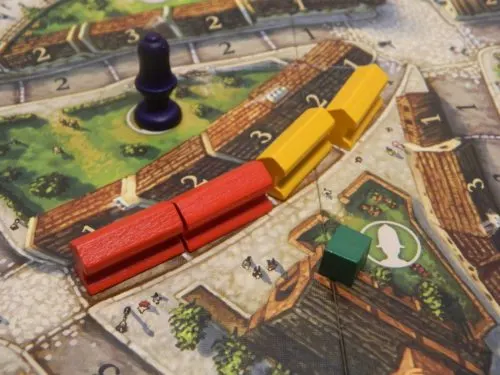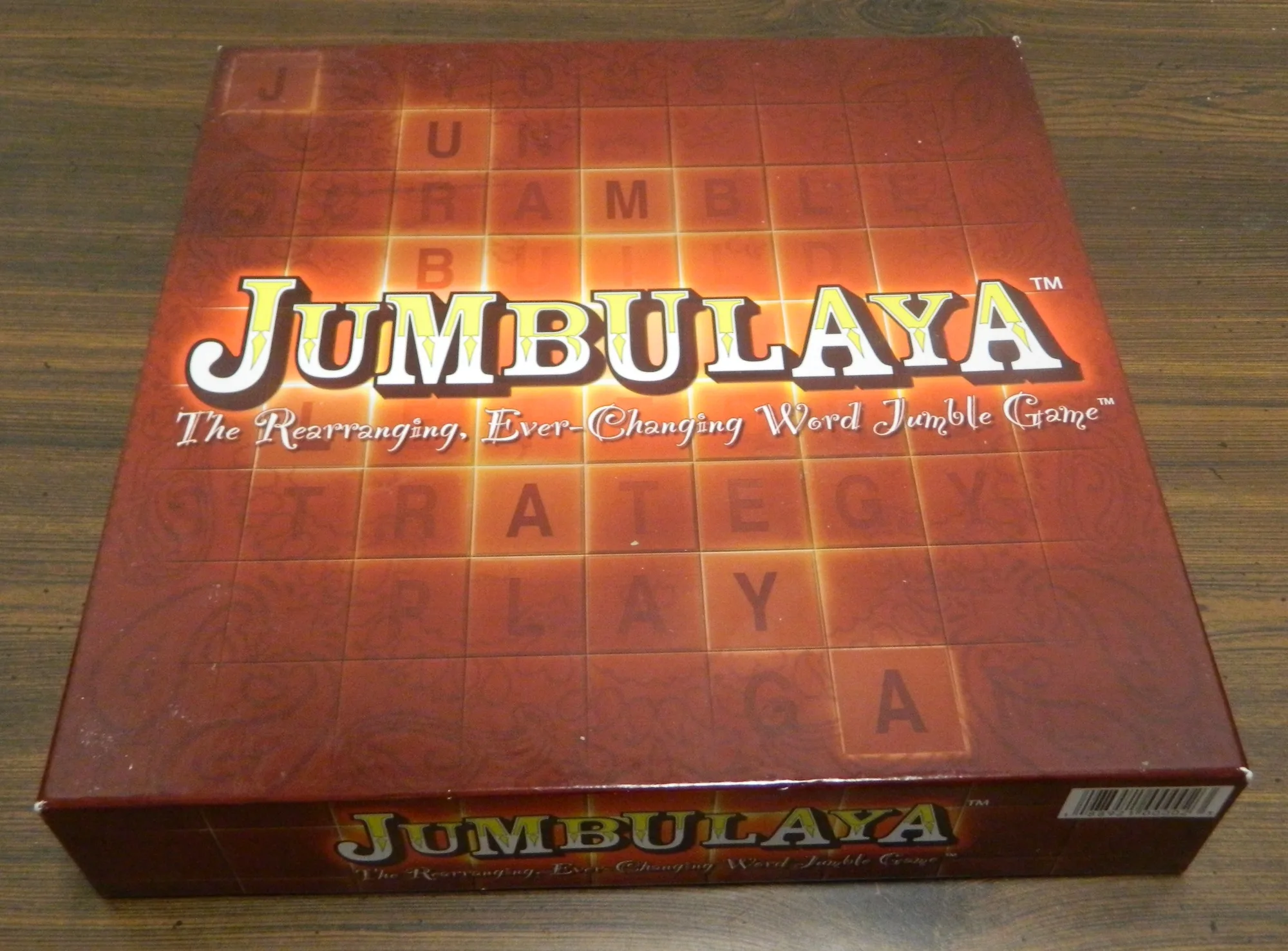Having played around 800 different board games, Ticket to Ride remains my favorite board game of all time. The game is close to perfect as it is accessible for the whole family while still retaining plenty of strategy to keep the whole family entertained. I bring this up because today’s game, Portobello Market, reminded me a lot of Ticket to Ride at first glance. The simple mechanics mixed with surprisingly deep strategy were quite similar. It is also hard to deny that placing the market stalls on the gameboard looked a lot like placing trains in Ticket to Ride. It was pretty obvious that the two games shared quite a bit in common. For all of these reasons I was really interested in checking out Portobello Market. Portobello Market is an interesting combination of mechanics that creates an accessible and yet strategic game that the whole family can enjoy.
How to Play Portobello Market
Setup
- Place the gameboard in the center of the table.
- Each player chooses a color and will take a number of corresponding market stalls based on the number of players.
- 2 players – 30 stalls
- 3 players – 20 stalls
- 4 players – 16 stalls
- Each player takes the corresponding reference board, scoring cube and three player action tokens. The player action tokens are placed face up.
- The neutral action tokens are placed next to the gameboard. The three tokens are placed on the top, followed by the two tokens, and the one tokens are on the bottom.
- All of the scoring cubes are placed on the ten space.
- Place all of the customers in the bag except for the baron (black customer) and the bobby. The baron is placed to the side of the board.
- The players choose who will go first. The first player will get to place the bobby on one of the districts.
Playing the Game
Before playing the game there are three terms related to the gameboard that must be addressed. Lanes refer to the streets where you place stalls. Squares are where two or more lanes meet. Districts are sections of the city surrounded by lanes which have a bobby symbol on them.
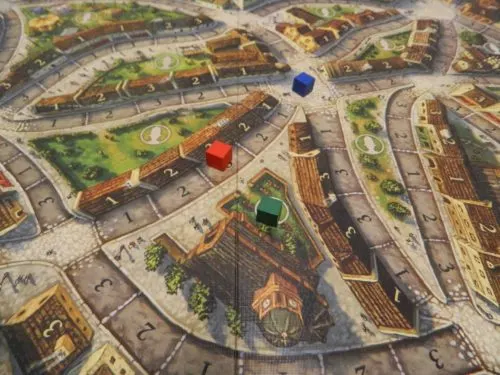
A lane is illustrated by the red cube. The blue cube is in a square. The green cube is in a district.
A player begins their turn by choosing which action token they would like to use this turn. The number on the action token they choose will determine how many actions they will be able to take this turn. When the player chooses a token they flip it over.
A flipped over token cannot be used again until all three tokens have been used. If all three action tokens are flipped over at the beginning of a player’s turn, they flip all of them back over which allows them to be used again.

This player has used all of their action tokens. They will flip over all of the tokens which means they can use them again.
The player will then take actions. The player can choose between four different actions. These actions can be done in any order and can even be performed several times.
- Place a Market Stall
- Place a Customer
- Move the Bobby (special action)
- Score a District (special action)
After a player has used all of their actions, play passes to the next player clockwise.
Placing a Market Stall
The first action that a player can take is placing one of their market stalls. The player can only place a stall on one of the lanes adjacent to current location of the bobby. If a player would like to place a stall in a different lane they may move the bobby to a different district (see Move the Bobby section).
If there are no stalls in a lane, the current player may place a stall on either end of the lane. If there are already stalls in the lane, the player must place it next to the last played stall.
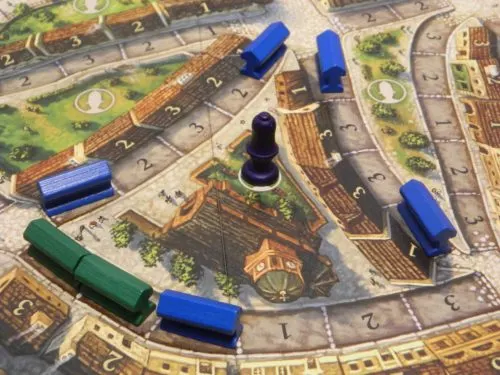
To begin this player’s turn the two green stalls were already placed. The blue player can place a stall on any of the spaces featuring a blue stall. If the blue player decides to place two stalls in either the left or right lane, the second stall has to be placed next to the first stall they placed.
Each stall that a player places counts as one action.
Placing a Customer
If a player want to place a customer they will draw one randomly from the bag (unless you are using the variant rule).

This player has drawn a gray customer. They will now have to place the customer on one of the squares on the gameboard.
The player then chooses which square on the gameboard they would like to place it. The customer can be placed on any unoccupied square even if it is not near the bobby’s current position. Each customer that is drawn and placed counts as one action.
Once all of the customers from the bag have been drawn, the baron (black customer) is placed on the board as the next customer.
If a customer has been placed on the squares at both ends of a lane and all of the spaces in the lane have a stall on them, the lane is immediately scored. All of the players who have stalls in the lane that is being scored will score points. Players first look at the color of the customers on both ends of the lane to determine the scoring multiplier:
- Gray to Gray – x 1
- Gray to Pink – x 2
- Pink to Pink – x 3
- Gray to Black – x 3
- Pink to Black – x 4
Each player will total the points on the spaces that they placed stalls on. This total is then multiplied by the scoring multiplier. Each player will move their scoring marker forward spaces equal to the points they scored.

This lane was completed so it is scored. As there is a gray customer on one end and a pink on the other end, this lane has a scoring multiplayer of two. The blue player will score six points ((1+2)*2). The red player will score twelve points ((3+2+1)*2).
Moving the Bobby
Moving the bobby is different from the other actions. Moving the bobby does not count as an action, and it can be moved whenever and however often the player prefers. When moving the bobby you will move it from one district to an adjacent district (you can only cross one lane each time you move the bobby). In order to move the bobby though the player may have to pay victory points. The amount of victory points that have to be paid are as follows:
- If the current player has the most stalls in the lane that is crossed, they do not have to pay any victory points.
- If there are no stalls in the lane, the player loses one victory point.
- If another player has the most stalls in the lane, the player has to pay one victory point to the player who has the most stalls in the lane (they lose a point and the other player gains a point). If there are two or more players tied for the most stalls, the player has to pay one victory point to each tied player. If the current player is tied for the lead with another player, they must still pay a point to the other tied player.
Scoring a District
A player is able to score two districts during the game. Unlike the other actions scoring a district takes up your entire turn. To score a district the player will either use their two or four action token (the token has to be face up at the beginning of your turn). The player chooses which district they would like to score. The player can choose any district that hasn’t already been scored. To note which district they are scoring they place their token on their chosen district.
The player counts up how many stalls they have on the three adjacent lanes (the value of the stalls doesn’t matter). This total is multiplied by two or four based on which token the player chose to play. Only the player who scored the district will score points. The player will move their point cube forward along the point track by the number of points they scored.
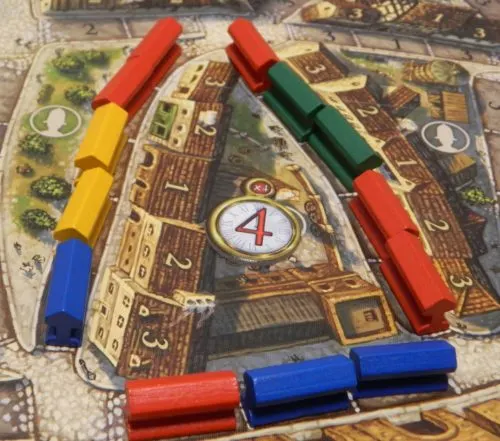
The red player has placed their four action token in this district. The red player has six stalls in this district. The player will score a total of 24 points (6 x 4).
After they have scored the district, they will leave their action token on the district for the rest of the game. To replace their missing action token, the player will take the top neutral action token from the stack on the side of the gameboard. This token is placed face up in front of the player and is used like any other action token for the rest of the game.
End of Game
The game ends when one of the players have placed their last market stall. The players who haven’t had their turn yet this round will get to take their turn before the game ends.
Once the game ends there may be some final scoring. Normally a lane is not scored if it is not fully completed during the game (all stalls are placed and there is a customer on both sides of the lane). Lanes with the baron as one of their customers will be still be scored even if all of the market stalls were not placed. The lane is scored in the same way as all other lanes.

This lane was not completed. As the baron is one of the customers, there will still be partial scoring. The green player will score 24 points ((1+2+3)*4). The blue player will score eight points (2*4).
The players then compare their scores. The player who has scored the most points wins the game.
Variant Customer Rule
Players can choose to use the variant customer rule. In the variant customer rule players will draw all of the customers at the beginning of the game. One customer at a time will be drawn and placed in a line with the baron placed last. When a player wants to draw a customer, instead of randomly choosing one from the bag, they will place the customer at the beginning of the line.

The players have decided to use the alternative customer rule. When a player wants to place a customer they will first place the customer on the left (gray). The next customer placed will be gray as well. This is followed by two pink customers and so on.
My Thoughts on Portobello Market
My initial impression of Portobello Market being similar to Ticket to Ride was both accurate in some ways and off in others. The two game’s gameplay share very little in common. In Ticket to Ride you are trying to complete different train routes. In Portobello Market the game is more abstract as you focus on controlling different lanes and trying to maximize your points. Their gameplay may be different but the two games still share a familiar feeling. Portobello Market is not as good as Ticket to Ride in my opinion but it shares a lot of things that I love about Ticket to Ride.
Lets begin with the fact that just like Ticket to Ride, Portobello Market does a great job making itself accessible to people of all ages. The game has a recommended age of 8+ and that seems appropriate. The game will take around five to ten minutes to explain to new players but the rules are quite straightforward. There are only a couple things you can do each turn and each mechanic is quite easy to comprehend. It might take you a couple turns to figure out what you are doing in the game. Afterwards the game plays very smoothly. For this reason I see Portobello Market being a great gateway game for people that don’t play board games outside of children’s games and games like Monopoly.
One thing that I think turns off a lot of people from more modern board games is that they think the games are too complicated and take too long. Neither are true for Portobello Market. Your first game is going to take a little longer as players figure out how to play the game. After everyone knows what they are doing though, the game moves pretty quickly. As long as no one suffers from analysis paralysis, your first game will probably take around 45 minutes. After that though I could see most games only taking around a half hour. I think the shorter length works well for the game as it is long enough to form a strategy but not too long where the game starts to drag on.
Despite being easy to play, Portobello Market still has enough decisions where it feels like you have a real impact on the game. There is a little luck in the game mostly involving drawing customers and whether the other players mess with your strategy. Otherwise your decisions will usually determine how well you do in the game. The player with the best strategy should usually win the game. Generally this is a good thing for a board game as it usually is not enjoyable playing a game where the outcome relies entirely on who is the luckiest.
The strategy in Portobello Market starts at the very beginning of your turn. Other board games have used a similar mechanic but I love the idea of the action tokens. The action tokens give you a choice over how many actions you want to perform on your turn. If you are in position to make a lot of moves you can use one of your higher tokens. If you are in a position where there isn’t much to do, you can use your lower tokens and save some of your moves for a future turn. You can either decide to take more turns now or on a future turn. This mechanic even adds a timing mechanic to the game as you want to make sure you have a high token available when the perfect opportunity arises. For such a simple mechanic it works really well.
After you have chosen how many actions you want to take, you then decide which actions you want to take. While the game only has four different actions, these actions add a decent amount of strategy to the game.
Lets begin with the action that probably adds the least strategy to the game. Placing customers in Portobello Market is a key mechanic but is usually a pretty obvious decision. Most of the strategy for this action comes from choosing when to use it. It is enticing to place market stalls out on the gameboard as they are what ultimately score you points. Timing when to place customers has a big impact on the game though. Placing customers is important as it can significantly increase the number of points you score or limit the points another player scores. Once you decide to draw a customer though the decision becomes pretty obvious. If you draw a pink customer you want to place it next to a lane(s) that contains a lot of your market stalls. If the customer is gray you want to place it where you don’t have any market stalls as it will limit the amount of points that other players can score.
I generally like this mechanic but it does add some luck to Portobello Market. You can always place gray customers on the other players’ lanes but it is always better to draw a pink customer and place it on one of your own lanes. If you keep drawing gray customers it does mess with your strategy a little. This is why I thought the included variant rule was interesting. As you draw all of the customers at the beginning of the game, there are no surprises in the game. You always know which customer will be placed next so you can plan ahead. This eliminates almost all of the luck from the game. In some ways this improves the game but in other ways it removes something from the game.
Probably the action that has the most impact on the game is placing your market stalls. This action drives all of the scoring in the game and gives you a lot of options in how you want to approach the game. At first you probably won’t have a firm idea of how you should place your market stalls. It seems like it would be best to just place your market stalls on the most valuable spaces. As you start playing the game though, this decision is not so simple.
The first deciding factor in where you should place your market stalls is for scoring. There are a couple different ways to approach placing market stalls in the game. This comes from the lanes in the game having different lengths. Some lanes consist of just two stalls while others have six stalls. Small lanes are valuable because you can score them quickly and you can gain control of them pretty easily. The longer lanes can score you a lot more points though if you take control of most of the lane. The problem is that long lanes are quite a bit riskier as they don’t score unless all of the stalls and customers are placed in the lane. You could use quite a few stalls in a lane and end up not scoring any points from it if it isn’t completed.
These two different types of lanes add some interesting strategy to the game. I think you could form a valid strategy focusing on either type of lanes or you could even pursue both types of lanes. I would recommend not spreading yourself out too thin though. As I can personally attest to, you don’t want to place a couple stalls in lanes all over the gameboard. This creates problems as you won’t be able to finish off all of the lanes that you place stalls in. These stalls will end up being wasted. You are much better off trying to place most of your stalls in the same area as it will also help you with district scoring.
District scoring is really interesting because it relies on a lot of timing. Basically district scoring allows players to score a lot of points if they are able to place a lot of their stalls around the same district. You could also technically score a district to prevent someone else from scoring it. As you can only score two districts during the game, timing can be key. As you have to use your two or four action token, you need to think a couple turns ahead so you make sure the chosen action token is still available when you want to use it. Timing is also important because you have no idea when the other players are going to score districts. As each district can only be scored once, you need to score a valuable district before someone else does it. There is also the fact that if you score a district early in the game you get to replace it with one of the better neutral action tokens. If you wait to score a district though you could score more points. Choosing when and which districts to score is a key decision in the game as it can score you a lot of points. If you can build up a district where you have a lot of your stalls, you can score quite a few more points than even your most valuable lane. With how valuable it is to score districts, you don’t want to miss out on not utilizing one of your tokens.
The other reason why choosing where to place your stalls is important comes down to moving the bobby. The location of the bobby is key as it determines where you can place stalls. If the bobby is not in the right place you won’t be able to place a stall in your desired location. You are then either forced to move the bobby which may cost you victory points or you won’t be able to place stalls where you would like to place them. This is where area control becomes really important because it can limit how many points you will have to pay to move around the board. If you control one of the main lanes in the game you can move around the board easier. You can also take victory points from the other players when they want to use the lane.
As I am usually a pretty stingy player, at first I did not want to pay victory points in order to move the bobby. I thought I was better off just placing stalls where the bobby was currently located. As you play the game though, you start to realize that moving the bobby is important. It sucks losing points just to move the bobby especially when you have to pay them to other players. If you use the movement wisely though you can score a lot more points than you have to give up. This can put you in a hole early in the game but can set you up to score a lot of points later in the game.
This is one reason why the scoring in Portobello Market is interesting. Unless you strictly focus on scoring a district quickly, you won’t score a lot of points early in the game. As the board fills up though you will reach a point where lanes and districts are scored left and right. Therefore if you fall behind early in the game, all is not lost. There are strategies that take longer to play out than others. Once you score a valuable lane you can easily jump from last to first. This does a good job keeping all of the players in the game until the very end.
If it wasn’t already clear I really enjoyed my time with Portobello Market. The game is not perfect though as I encountered a few issues.
I would say that the biggest issue I had with Portobello Market is that it is one of those games where it is not immediately evident what strategy you should pursue. For most of your first game you probably aren’t going to have much of a strategy as you won’t know how your actions are impacting your final score. As you reach the end of your first game though you will start seeing what you did right and wrong and adjust for future games. The only concern I have with this is that I am a little leery about how many different types of strategies you can implement in the game. I see Portobello Market as the type of game where you will want to keep implementing the same strategy once you find a strategy that works well for you. This could lead to Portobello Market getting a little repetitive after a while. I really enjoyed Portobello Market but I don’t see it as the type of game that I would play all of the time.
It might not look like your typical abstract strategy game but Portobello Market does share a lot in common with the genre. The game utilizes a theme of 1901 London where you are playing as a merchant trying to set up stalls around the city. I found this to be a really interesting theme. Its unfortunate that the game doesn’t use it very much. The theme has no impact on the gameplay at all as you could apply many other themes that would have worked just as well with the gameplay. This is actually not that surprising as the game was initially designed as a train game until it eventually adopted the market theme. The lack of theme doesn’t ruin Portobello Market but I think the game could have been better if it utilized it a little more.
While this doesn’t impact the gameplay at all, Portobello Market’s components are fantastic. Longtime readers of Geeky Hobbies will know that I am a sucker for wood game pieces. The game utilizes wood for the market stalls, customers and the bobby. The game could have easily used plastic for these pieces, but the wood pieces are a really nice touch. I also applaud the wood pieces because they look like custom pieces instead of generic pieces used in a lot of other board games. The cardboard pieces are also pretty good. The game’s artwork is great and does a good job supporting the game’s theme.
Should You Buy Portobello Market?
While it was not quite the Ticket to Ride style game that I was hoping it would be, I still really enjoyed Portobello Market. Portobello Market has a similar feeling to Ticket to Ride but the gameplay is quite different. One thing the two games share in common is that they are quite accessible and still have quite a bit of strategy beneath the surface. The game is simple enough that the whole family can enjoy it and yet it has enough strategy that it should keep everyone interested. Portobello Market has some really interesting mechanics and they work well together to give players quite a few options. The component quality is also fantastic. I really enjoyed playing Portobello Market but the game has a few issues. It is hard at first to come up with a good strategy, and once you come up with it I fear players will just use the same strategy every game making the game repetitive after a while. The game also doesn’t do a great job utilizing its theme as it has no impact on the gameplay at all.
If the premise doesn’t really interest you or you are not a fan of light to moderate abstract strategy area control games, you probably won’t like Portobello Market. If you already have a very similar game, I don’t know if Portobello Market is special enough to warrant a purchase. People who are intrigued by the premise and are looking for a more accessible game that still has strategy should enjoy their time with Portobello Market. I would recommend that they pick up Portobello Market.
If you would like to purchase Portobello Market you can find it online: Amazon, eBay

